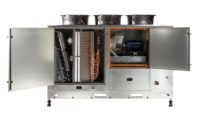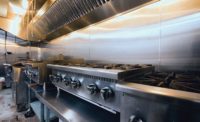Dedicated outdoor air systems (DOAS) have been available for over 20 years, with the primary benefit being the ability to decouple outdoor air tempering from conditioned space thermal loads that can be handled by separate, secondary systems. Another key advantage of a DOAS is precise temperature and humidity control that may be difficult to achieve with a single air handling system such as a multi-zone VAV system.
State-of-the-art DOAS products can be used to provide precise temperature and humidity control year-round with Integrated Energy Efficiency Ratios (IEER) that exceed 20. Figure 1 shows the internal components on the supply air side of a DOAS unit from the outdoor air intake on the left to the supply fan on the right, with outdoor fans showing on top of the unit. Multiple sensors incorporated into units allow sophisticated control of components and subsystems to enhance reliability and energy performance. Remote monitoring and diagnostics allow setpoint and operational changes to be made off-site, which reduces the frequency and cost of on-site maintenance.
Although a DOAS can provide space heating through many different sources such as a combination of heat pump and auxiliary electric or gas heating, the focus here is on summer cooling conditions where moisture removal is necessary. Figure 2 illustrates a single-zone summer cooling scenario on a psychrometric chart for a DOAS with energy recovery and hot gas reheat. Outdoor air conditions are indicated by the point OA, from which a total energy recovery wheel cools and dehumidifies the air to point ER. The desired indoor conditions are represented by point I. All possible supply air states are to the right of the curve that connects point A, the minimum cooling possible, to point B, the maximum cooling possible, through the use of reheat.
When exact space conditions need to be met, sensible reheat can be provided by a reheat coil that serves to reject some of the condenser heat into the supply air downstream of the cooling coil. Figure 2 also shows how a DOAS can provide precise temperature and humidity control for different space thermal and moisture load ratios (sensible heat ratios). Two supply air examples are shown, one from point 1 to I, the other from point 3 to I. When the space sensible heat ratio is high e.g., not much internal moisture gain, then cold air can be supplied directly to the space as shown by point 1. The supply air is generally delivered at a dew point of less than 50ºF in these scenarios.
However, when substantial moisture gains exist, it is not possible to reach point I directly from the cooling curve. Cold air at point 2 needs to be reheated to point 3 so the space temperature and humidity conditions can both be satisfied at point I. Here, the supply air should be delivered at a supply air dew point of less than 45ºF. Multiple zones can be handled with a single DOAS but might require separate secondary systems to aid comfort in individual zones.
A principal advantage of using a DOAS is to condition outdoor ventilation air independent of internal loads. In these applications, it’s helpful to recognize the importance of latent loads associated with dehumidification. Studies have shown that the ratio of annual latent to sensible cooling energy required for ventilation air can be larger than 7 to 1, in terms of ton-hrs/scfm/yr. Table 1 contains values for various cities in the U.S. published by Harriman et al.1 By using a DOAS to decouple moisture removal from sensible cooling loads, a traditional HVAC system can be sized primarily to handle the sensible load, not both sensible and latent loads.

TABLE 1. Annual latent vs. sensible cooling loads for ventilation air, from Harriman et al.1

FIGURE 2. Sample psychrometric chart of DOAS control of temperature and humidity.
Several features enable modern DOAS units to accomplish air tempering objectives in a cost effective, energy efficient, and reliable manner. With extremely versatile designs, DOAS units can be operated very efficiently at part load conditions, which allows for high values of IEER to be attained. Nearly all DOAS functions can be modulated by using variable speed fans, compressors, and heating systems. Several optional features can be added when required to enhance the operation of units and fit each application’s needs.
In addition to high-quality hardware, sophisticated arrays of sensors and control logic ensure that units operate at peak performance regardless of the mode of operation, percentage of full load, or climate conditions. Figure 3 shows the air intake and conditioning portion of a premium DOAS unit, including, from left to right, low leakage outdoor air dampers, standard metal mesh filters, two layers of particulate air filtration, a seven row indoor coil with an electronic expansion valve, and a reheat coil with fully modulating hot gas reheat valves.
Energy Recovery
Tempering outdoor air with exhaust using an energy recovery device is one of the most efficient means for handling the heating or cooling load associated with outdoor air. When properly integrated with a DOAS, an energy recovery device can significantly reduce a system’s tonnage requirement. In many applications, ASHRAE Standard 90.1 requires this feature to be at least 50% effective where the exhaust is centralized; however, not all applications are amenable to this requirement. Examples include commercial kitchens where the exhaust contains a significant amount of grease, or laboratories where harmful contaminants exist in the exhaust airstream. Total energy recovery wheels are often specified to transfer moisture, in addition to heat, between the supply and exhaust airstreams, cooling and dehumidifying the air in summer and heating and humidifying it in winter.
Sensors
The ability to measure various data points in the supply and outdoor airstreams and refrigeration circuit plays an essential role in properly controlling a DOAS unit. When moisture control is a priority, it is critical to know the supply air properties at any given point along the paths displayed in Figure 2. By utilizing temperature and humidity sensors at DOAS locations corresponding to points OA, ER, 1 or 2, 3 and I in Figure 2, the supply air can be conditioned to the exact values required to maintain space setpoints.
Similar to air sensors, pressure transducers and line temperature sensors can be installed in key locations of the refrigeration circuit to modulate individual components for optimal performance. At any given moment in time, a system with such sensors will be capable of automatically adjusting to changing ambient and load conditions.
Controls
Several internal, independent Proportional-Integral-Derivative (PID) control loops can be used to control various components such as compressor speed, outdoor fan speed, electronic expansion valve (EEV) position, and hot gas reheat valves with input from some of the previously mentioned sensors. Combined, they provide the maximum performance possible over the entire operating range of the unit, resulting in a high IEER. For example, under part-load cooling conditions, as the compressor will generally have the largest single power requirement, the condensing pressure is automatically reduced and the evaporating pressure increased by operating the fans at more than typical part load speed, to reduce the total unit power consumed.
In addition to performance and efficiency, unit safety and component longevity are important features of a premium system. By integrating safety logic with feedback from multiple sensors such as high and low refrigeration pressure, compressor oil level, and high and low supply air temperature, units are able to self-diagnose potential issues and resolve the problem at hand before noticed by the enduser.
Remote Monitoring
Another advantage of having a unit with several strategically located sensors is the capability of remote monitoring. Cloud-based software allows real-time performance to be observed and recorded. When this is coupled with email alerts, faults can be quickly identified by comparing anticipated performance with measured values. In addition to monitoring, issues can be resolved remotely by a service technician capable of changing set points or operating parameters over the internet.
Monitoring can greatly reduce the time between a fault, the necessary maintenance, and cost to the owner. If on-site maintenance is required, the response and resolution will be more rapid and less costly. Figure 4 illustrates how a DOAS can control both space temperature and humidity simultaneously, showing the outdoor and space temperatures and humidity over a six-hour period, with set points of 74°F and 60% rh.

FIGURE 4. Monitored record of outdoor and conditioned space temperature and humidity values.
Sample Application Characteristics
In summary, standalone DOAS units and those coupled with secondary systems allow precise temperature and humidity control to be achieved year-round. Let’s close with some environments where a DOAS-based design can make good sense when properly tailored to the particular setting. The driving factor behind all of the following applications is a high outdoor air volume requirement, particularly with high moisture content. Due to the expense of conditioning outdoor air — and in many cases the necessity for continuous operation — this must be done as efficiently and economically as possible.
Hotel Corridor Pressurization
-
High occupancy rates and bathroom exhaust rates drive fresh air requirements 24/7.
-
Neutral temperature and humidity supply air conditions must be maintained independent of ambient conditions.
-
Generally requires the supply air, rather than the conditioned space, to maintain a certain temperature or humidity.
-
Pressurized corridors minimize ventilation air ducting to individual rooms while still providing fresh air requirements and smoke control.
-
Individual room temperature and contaminants are contained to each room.
Grocery and Convenience Stores
-
High occupancy levels require a high volume of outdoor ventilation air.
-
High sensible internal cooling loads occur from lighting, internal refrigeration equipment, and occupants.
-
DOAS couples well with traditional RTUs to handle the internal loads.
-
Generally, these locations will require a schedule and various percentages of outside air based on hours of operation.
-
Dehumidification is critical; high levels of moisture create condensation on refrigerated display case doors.
Hospitals and Clinics
-
High occupancy and fresh air rates require a high volume of outdoor air 24/7.
-
Elevated internal loads from lighting, medical equipment, and occupants.
-
Couples well with traditional RTUs to handle internal cooling loads.
-
Sensitive medical equipment and procedures often require precise temperature and humidity control.
-
Often incorporates a BMS system to control all rooftop equipment.
-
Redundancy on outdoor air equipment is common.
-
High operational costs make energy efficiency appealing.
Schools
-
High occupancy and increasing indoor environmental quality (IEQ) requirements drive outdoor air volume.
-
Couples well with VRF systems.
-
Computer labs and athletic facilities have high internal loads compared to classrooms and offices.
-
Scheduled controls allow for varying percentages of outdoor air.
-
Dehumidification generally used to maintain superior IEQ.
Commercial Kitchens
-
Outdoor air volume required for dining area along with makeup for kitchen exhaust.
-
DOAS pairs well with traditional RTUs for high sensible gains, and dedicated makeup air equipment for kitchen exhaust.
-
Scheduled control allows for 100% outdoor air during occupied times and 100% return air for unoccupied times.
-
Reheat is not needed due to extremely high internal sensible gains.
-
Energy recovery is usually not utilized because of grease and other contaminants in kitchen exhaust air.
References
-
Harriman, Lewis G. III, Plager, Dean and Kosar, Douglas, “Dehumidification and Cooling Loads From Ventilation Air,” ASHRAE Journal, November 1997.
Bibliography
a. Horton, Doug. “Optimizing Airflows in Foodservice Facilities: Part 1 ‒ Optimizing Entering Airflows.” Engineered Systems, December, 2015.
b. Crowther, Hugh, “Energy-Efficient Makeup Air Units,” ASHRAE Journal, March, 2015.
c. Mumma, Stanley A., “Understanding and Designing Dedicated Outdoor Air Systems (DOAS),” Seminar at AHR Expo, January 2017.
d. ASHRAE 2016 Handbook, HVAC Systems and Equipment, Ch. 4, Air Handling and Distribution.
Typical Design and Benefits of a High Standard DOAS
Air intake. Integrated louvers and low leakage, modulating damper paired with multiple layers of outdoor air filtration maximize indoor environmental quality.
Energy recovery. Variable speed total energy wheel aids in reducing loads associated with conditioning outdoor air.
Refrigeration system. Inverter driven, variable speed compressor and electronically commutated motor condensing fans paired with an EEV allow for maximum efficiency and turndown of refrigeration capacity.
Dehumidification. Wide, multi-row evaporator coil design and modulating, hot gas reheat offer precise moisture and humidity control of supply air.
Supply fan. Variable speed, direct drive supply fan eliminates belts and pulleys to reduce maintenance and service costs.
Heat exchanger. Condensing, indirect gas furnaces provide up to 90% combustion efficiency, diminishing operating costs.
Electrical controls. Various supply air and refrigeration sensors enable controls to accurately combine each feature into a unified system customized for each application.
Communications. Multiple sensors and built-in communications allow local and remote monitoring and annunciation of operational status, faults, and possible need for maintenance.
Construction. Exterior double wall steel liners are filled with R-13 foam insulation to minimize thermal heat transfer into and out of the unit.








